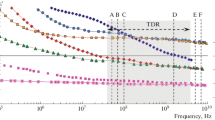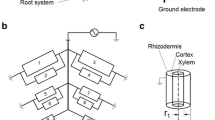Abstract
Based on batch experiments conducted on soil samples in the laboratory, the relationship between dielectric constant and water content based on electrical capacitance measurement was investigated. Factors that may affect the relationship, such as measurement frequency, electrode array methods, and soil particle sizes, were analyzed. A model fitting the relationship between dielectric constant and water content was proposed. The results clearly indicate that even with the use of rod-like sensors, the measured electrical capacitance with 1 kHz frequency can be used to construct a good relationship between dielectric constant and water content. Although the electrode array methods (parallel or non-parallel electrode pair) and soil particle sizes do affect the obtained absolute values of dielectric constant to some extent, the relationship between dielectric constant and water content remains unchanged. A clear characteristic is the increase reduction in the dielectric constant at near saturation condition, and the low increase speed when water content is small. The proposed modified VG model incorporated this characteristic into it and fitted the data better than the reported models. These results suggest that the electrical capacitance-based dielectric constant measurement can be extensively used and would be useful, especially in the situations where parallel sensor requirement is difficult to satisfy.









Similar content being viewed by others
References
Baumhardt RL, Lasano RJ, Evett SR (2000) Soil material, temperature, and salinity effects on calibration of multisensor capacitance probes. Soil Sci Soc Am J 64:1940–1946
Chanzy A, Tarussov A, Judge A, Bonn F (1996) Soil water content determination using a digital ground-penetrating radar. Soil Sci Soc Am J 60:1318–1326
Dean TJ, Bell JP, Baty AJB (1987) Soil moisture measurement by an improved capacitance technique: part I. Sensor design and performance. J Hydrol 93:67–78
Fares A, Alva AK (2000) Soil water components based on capacitance probes in a sandy soil. Soil Sci Soc Am J 64:311–318
Fares A, Buss P, Dalton M, El-Kadi AI, Parsons LR (2004) Dual field calibration of capacitance and neutron soil water sensors in a shrinking–swelling clay soil. Vadose Zone J 3:1390–1399
Friedman SP (1998) A saturation degree-dependent composite spheres model for describing the effective dielectric constants of unsaturated porous media. Water Resour Res 34:2949–2961
Houser PR, Shuttleworth WJ, Famiglietti JS, Gupta HV, Syed KH, Goodrich DC (1998) Integration of soil remote sensing and hydrologic modeling using data assimilation. Water Resour Res 34:3405–3420
Kelleners TJ, Soppe RWO, Ayars JE, Skaggs TH (2004) Calibration of capacitance probe sensors in a saline silty clay soil. Soil Sci Soc Am J 68:770–778
Kool JB, Parker JC (1988) Analysis of the inverse problem for transient unsaturated flow. Water Resour Res 24:817–830
Loew A, Mauser W (2008) On the disaggregation of passive microwave soil moisture data using a priori knowledge of temporally persistent soil moisture fields. IEEE Trans Geosci Remote Sens 46:819–834
Malicki MA, Plagge R, Roth CH (1996) Improving the calibration of dielectric TDR soil moisture determination taking into account the solid soil. Eur J Soil Sci 47:357–366
Paltineanu IC, Starr JL (1997) Real-time soil water dynamics using multisensor capacitance probes: laboratory calibration. Soil Sci Soc Am J 61:1576–1585
Polyakov V, Fares A, Ryder MH (2005) Calibration of a capacitance system for measuring water content of tropical soil. Vadose Zone J 4:1004–1010
Regalado CM, Ritter A, Rodríguez-González RM (2007) Performance of the commercial WET capacitance sensor as compared with time domain reflectometry in volcanic soils. Vadose Zone J 6:244–254
Robinson M, Dean TJ (1993) Measurement of near-surface soil-water content using a capacitance probe. Hydrol Process 7:77–86
Robinson DA, Gardner CMK, Cooper JD (1999) Measurement of relative permittivity in sandy soils using TDR, capacitance and theta probes: comparison, including the effects of bulk soil electrical conductivity. J Hydrol 223:198–211
Robinson DA, Kelleners TJ, Cooper JD, Gardner CMK, Wilson P, Lebron I, Logsdon S (2005) Evaluation of a capacitance probe frequency response model accounting for bulk electrical conductivity: comparison with TDR and network analyzer measurements. Vadose Zone J 4:992–1003
Roth K, Schulin R, Flühler H, Attinger W (1990) Calibration of time domain reflectometry for water content measurement using a composite dielectric approach. Water Resour Res 26:2267–2273
Sakaki T, Rajaram H (2006) Performance of different types of time domain reflectometry probes for water content measurement in partially saturated rocks. Water Resour Res 42:W07404. doi:10.1029/2005WR004643
Santamarina JC, Fam M (1997) Dielectric permittivity of soils mixed with organic and inorganic fluids (0.2 GHz to 1.30 GHz). J Environ Eng Geophys 2:37–51
Smith-Rose RL (1933) The electrical properties of soils for alternating currents at radio frequencies. Proc R Soc Lond 140:359
Starr JL, Paltineanu IC (1998) Soil water dynamics using multisensor capacitance probes in nontraffic interrows of corn. Soil Sci Soc Am J 62:114–122
Topp GC (2003) State of the art of measuring soil water content. Hydrol Process 17:2993–2996
Topp GC, Davis JL, Annan AP (1980) Electromagnetic determination of soil water content: measurement in coaxial transmission lines. Water Resour Res 16(3):574–582
Van Genuchten MT (1980) A closed-form equation for predicting the hydraulic conductivity of unsaturated soils. Soil Sci Soc Am J 44:892–898
Wang JR, Schmugge TJ (1980) An empirical model for the complex dielectric permittivity of soils as a function of water content. IEEE Trans Geosci Remote Sens 18:288–295
Acknowledgments
This work is part of research projects “Desaturation processes in vadose zone” and “Electrical properties of and resistivity tomography for water transfer process in soil–plant–atmosphere continuum”, which are supported by Natural Science Foundation of China (40371021, 40771038).
Author information
Authors and Affiliations
Corresponding author
Rights and permissions
About this article
Cite this article
Wu, S.Y., Zhou, Q.Y., Wang, G. et al. The relationship between electrical capacitance-based dielectric constant and soil water content. Environ Earth Sci 62, 999–1011 (2011). https://doi.org/10.1007/s12665-010-0585-4
Received:
Accepted:
Published:
Issue Date:
DOI: https://doi.org/10.1007/s12665-010-0585-4




